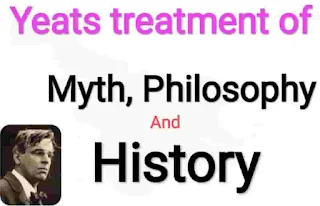Yeats treatment of myth, philosophy and history
The treatment of myth, philosophy and history constitutes an important aspect of Yeats's poetry. His system as contained in his philosophical work, A Vision, is the theoretical basis for the way he handles history and myth in some of his poems. His early poems largely deal with Irish mythology and are pregnant with symbolic meanings. As for history, he referred to the rise and fall civilisations and believed that the nature of civilisation changes after almost every two thousand years.
William Butler Yeats's theory of the rise and fall of civilisations finds an illustration in ‘The Second Coming’ This poem is one of those few poems which require some knowledge of Yeats's philosophy of history for a clearer understanding. Yeats believed that the process of history was a cyclic one. He compared it to the movement of rapidly fotating gyres or cones. The gyres spin swiftly round a fixed centre. Their circumference widens as they rotate and ultimately disintegration sets in. The disintegration begins at the circumference, and gradually reaches the centre.
Yeats believed that the present cycle of history began two thousand years ago, with the birth of Christ and the revelation. Previous to that there was the Greek-Roman civilisation, which in its turn began in 2000 B.C. with the mating of the god Zeus and Leda. Helen and Clytemnestra were born as a result of his union and then followed the various events.
The Pagan civilisation broke down after a life of two thousand years; Christ came, and a new civilisation was born out of the ruins of the earlier one. Similarly, the Christian civilisation has nearly run its course of two thousand years and so believes Yeats, a Second Coming is at hand. Yeats feels that the forces of Christian love are almost spent and that a new, brutal force is about to take over:
And what rough beast, its hour come round at last, Slouches towards Bethlehem to be born?
These two lines contain a terrifying vision of impending savagery. The diminishing impetus of Christianity is conveyed through the idea in the opening lines, that Christianity is like a falcon that has lost touch with the falconer, and is thus lost and directionless.
In Easter 1916, we again see Yeats's myth-making imagination at work. He transforms and modifies old myths to suit his purpose, he even creates new myths. This poem deals with contemporary Irish history. The opening lines of the poem convey the impression that some legendary figures are coming out of the dead past to take part in the activity of the present. The Irish revolt merges into Yeats's philosophy of history. Those very revolutionary whom he had come to despise attained heroic stature and it seemed to Yeats that a terrible beauty had been born.
It was then that he realised that these Irishmen had stopped ‘burning damp forgots’ and had achieved a permanence which he set down to celebrate in this poem. The heroic intensity had transcended the cycle of ordinary life and achieved permanence in the midst of flux.
It is this permanence and the heroism which Yeats celebrates in his poem Easter 1916, although he had his doubt about the expediency of the political upsurge and the actions of the rebel heroes.
Thus Yeats's handling of myth and history is really competent even when he believed in developing and sticking to his own very individual and very private sense of history and mythology. What is much more remarkable is the wonderful poetic use he made of these notions and gave us poems which even when expounding one or the other notion remains superb.



